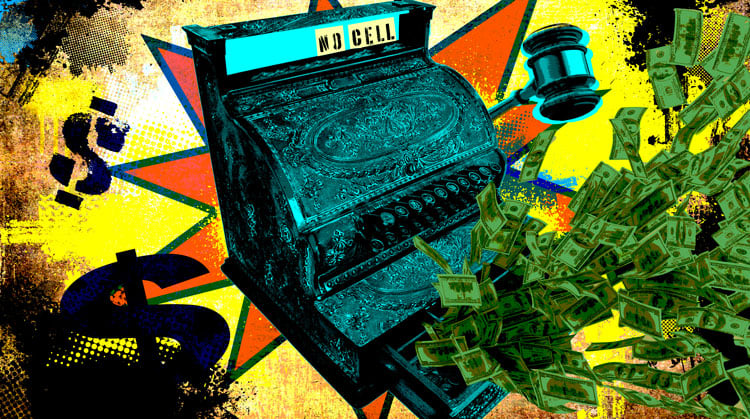Cash-register justice: Fees collected from defendants are funding the system

Illustration by Brenan Sharp/ABA Journal.
Eight years after Cory Lovelace’s 2006 Valentine’s Day death in downstate Illinois from undetermined causes, investigators charged her husband, Curtis, with her murder. Unable to post bond, Lovelace spent nearly two years in jail, incarcerated just miles from the county courthouse where he once served as an assistant state’s attorney. Lovelace lost his job, the family home and his savings.
After two trials, Lovelace was acquitted. The first trial, in February 2016, was declared a mistrial after the jury deadlocked. The second murder trial, in a different downstate county, resulted in a swift “not guilty” verdict, with jurors deciding prosecutors hadn’t proved their theory that Lovelace smothered his wife to death in bed.
When Lovelace petitioned for the return of the full $350,000 bond his friends posted on his behalf, the Adams County Clerk’s Office held back an “administrative fee”—$35,000 plus $5,433.75 in costs for the 277 days that Lovelace was on electronic monitoring.
“I can tell you, being the defendant and having to look at the people who gave that money to the court so I could spend nine months with my family instead of a county jail before trial, it doesn’t seem like an administrative fee,” Curtis Lovelace says. “What it sounds like is ‘How dare you not plead guilty and you actually go to trial? How dare you do that?’”
Lovelace appealed the fee decision, and advocates hoped Curtis Lovelace v. People of the State of Illinois might be among the small number of cases the U.S. Supreme Court would include this term, but the court ultimately passed on the case.
“Mr. Lovelace’s story is distressing and outrageous, but not unique,” wrote Jeffrey T. Green, co-chair of the amicus committee at the National Association of Criminal Defense Lawyers in a January 2019 friend-of-the-court brief. “His life was destroyed and his reputation sullied; he endured the indignities of incarceration for two years; his family suffered. At the conclusion of it all, Illinois handed him an additional $35,000 bill.”
A price on freedom
Seeking to protect its citizens from the sometimes vigilante efforts of bail bondsmen, in 1963, Illinois became one of the first states in the country to outlaw a commercial bail system. When a defendant is brought into one of Illinois’ 24 judicial circuits on charges, judges set conditions of bail to assure the court that the defendant will return for trial.
Illinois courts are allowed to retain 10% of bond payments as an administrative fee. In 1971, the U.S. Supreme Court upheld these fees in the case of Schilb v. Kuebel, which means criminal defendants across the country have had to forfeit significant portions of their bond payments, even when they comply with conditions of bail.
“Bail is not designed to raise money for the circuit clerk. It’s not designed to punish someone who is presumed innocent at that point,” Lovelace says. “It’s only there to ensure that they show back up to court, so that’s what the court should be doing. ‘What is the appropriate amount so they show back up to court?’ And that’s just not being done.”
In its writ of certiorari on behalf of Lovelace, the Exoneration Project, a free legal clinic at the University of Chicago School of Law that represents the wrongfully convicted, wrote that the Schilb decision has allowed Illinois, as well as states and counties around the country, to retain enormous sums from the bail bonds of acquitted defendants, with some jurisdictions retaining as much as 30%.

Lindsay Hagy. Photo courtesy of Goldberg Kohn.
“We believe that withholding $35,000 as a bond forfeiture fee from an acquitted and indigent defendant violates both the Eighth Amendment and due process, and we also felt that it’s not properly considered a fee under state law,” says Lindsay Hagy, who co-authored the petition. “The judge on the trial court level said that bond forfeiture fees are basically one of the ways that the clerk’s office funds their office. And so we believe under Illinois law that a fee can only be something that is specific to costs undertaken for a defendant and not just a general fund.”
In Nebraska where, like Illinois, the judicial system serves the role of bail bondsman, the clerk returns 90% of a defendant’s bond payment and keeps 10%, even if the defendant makes all scheduled court appearances. To secure their release before trial, defendants appearing before Oregon courts must pay a cash amount equal to 10% of the “security amount” the judge sets for their release. If the defendant makes all scheduled appearances, the court returns 85%, keeping the remaining 15% but no more than $750.
And in some states that allow bail bond agents to intervene with the courts on behalf of defendants, bondsmen can charge between 10% and 15% of the total bail, along with other fees, regardless of the outcome of the case.
“What we’ve seen not only in Illinois but in states around the country is that the criminal justice system is funded by money extracted from the defendant. This can be from fines, ordinance violations, traffic tickets, GPS monitoring fees, for example, fees for pretrial services, fees for release pending trial,” says Devin Taseff, a Peoria, Illinois-based attorney who wrote a critique of Illinois’ 2017 bail reform act, which removed the monetary cash bail requirement for those charged with nonviolent, low-level offenses.
But in recent years, some jurisdictions have found ways to rely less on monetary conditions of bail. New York City and Washington, D.C., courts release at least 70% of their felony pretrial defendants on their own recognizance. Both cities, observers say, maintain high court appearance rates and low re-arrest rates. And in October 2019, California became the first state to end cash bail.
See also: The Bail Project pays defendants’ bail as part of a plan to end money bail entirely
In Illinois, legal experts and bail reform advocates want the 57-year-old bail bond retention statue revised, saying it leads to a cycle of debt, homelessness, unemployment and recidivism and constitutes a conflict of interest between the courts and its citizens.
Proponents of bail bond reform argue that bond retention statutes are unconstitutional, unfairly place the cost of criminal justice on the backs of defendants before they have been convicted of any crime, and result in innocent people pleading guilty, many of them indigent. Illinois courts don’t withhold an administrative fee at all from defendants who can afford to post the entire bail amount set for their release, further increasing the financial inequity.
“The way Illinois continues to operate is not consistent with the constitution,” says Lisa Foster, co-director of the Fines and Fees Justice Center, one of several groups that filed an amicus brief with the U.S. Supreme Court in support of a review of Lovelace’s $35,000 bond forfeiture. “Illinois has characterized their bond fee as ‘Oh this isn’t a fee that applies upon conviction, this is a fee that applies to everybody, convicted or not.’”
Cook County—Illinois’ largest judicial circuit—capped bond fees at $100 in 2016, but districts throughout the rest of the state still withhold 10%.
“If you live in Chicago, the most they can assess is $100. If you live anywhere outside of Chicago, they can get you for a lot more, and that doesn’t make a whole lot of sense,” says Foster, who also has served as director of the Office for Access to Justice at the U. S. Department of Justice and as a California Superior Court Judge in San Diego.
As an example of the type of revenue states are generating, prior to implementing the $100 cap, records from 2013 show the Cook County clerk retained $5.6 million from defendants as bail bond fees.
“When we’re talking about the specific instance where someone hasn’t been convicted yet—they haven’t gone to trial, and you’re taking money from them and using that to keep your services going, I see that as a recipe for disaster,” Taseff says.

Curtis Lovelace. Courtesy of the Justice Initiative/file photo.
Prisoner’s dilemma
As a former prosecutor, Curtis Lovelace was intimately familiar with bond practices in the criminal justice system. Lovelace says bail costs often resulted in defendants deciding that pursuing their day in court may not be their best financial option.
“I’ve watched people plead guilty to crimes that they didn’t even commit because they couldn’t afford a $1,000 bond. The only way they were going to get out of jail on a lower-level offense where their bail was set at $10,000 was to plead guilty,” Lovelace said.
“Many people have jobs. If they have to spend even a week in jail on pretrial confinement, when they got out of jail they wouldn’t have job. They would be unemployed. And you would see the bad cycle that that would create—poverty, potential for future crimes.”
But there is momentum in some states to change fee statutes. The Illinois Supreme Court has convened a group of judges, prosecutors and pretrial administrators to review pretrial practices in Illinois. After two years of guidance from the National Institute of Corrections, four public hearings around the state as well as examining written comments from legal and criminal justice reform experts, the Illinois Commission on Pretrial Practices is poised to release recommendations on how to reduce the state’s reliance on monetary bail.
“If Illinois continues to move from a resource-based system of justice to a risk-based system, there will be less reliance on monetary conditions of release,” the commission wrote in December 2018.
Conflict of interest
Activists decry the reliance on fees to finance court operations and say they may serve as perverse incentives for trial court judges as they set conditions for bail. For example, in Winnebago County, Illinois, cash bail proceeds bring in more than $500,000 annually. The money is split between the circuit clerk’s office and the sheriff’s office.
“I don’t know that I have ever seen less than 10% in bond fee withheld. That’s one of the ways the [circuit] clerks basically fund their office,” Adams County Circuit Judge Bob Hardwick said at an April 2017 hearing he convened to determine how much of Lovelace’s bond would be returned.
Lovelace says that’s a problem, and he notes that county judges and prosecutors often arbitrarily determine bail based on how much they think they can get from a defendant.
“They’re sort of eliminating the reasonableness by setting bond amounts at an amount looking at the 10%,” Lovelace says. “They’re actually backing it up and increasing the amounts to make it basically so people are unable to pay the bond. And then when they are able to pay the bond, they have to pay this outrageous fee.”
Three years after his March 2017 acquittal, Lovelace is working as a criminal defense attorney in Adams County, Illinois, where he believes his case has ratcheted up the conditions of bail for defendants charged with murder.
“The case that I just tried in Adams County, the defendant was arrested in 2017 for murder, and his bond was set at $5 million,” Lovelace said. “For whatever reason, in that county, after my case, the going rate for a bond for a murder charge became $5 million. And again, there’s no rhyme or reason.”
Lovelace says the bond retention fee needs to be capped at $100 throughout the state of Illinois, but that it may be an uphill battle.
“Cook County was a big enough population base and had enough political clout that they could do whatever they wanted. … They’re relying upon those funds, not just my $35,000, but 10% of any cash bond posted—is going to fight that,” Lovelace says.

Devin Taseff. Photo courtesy of Heyl Royster.
Taseff says that courts outside of the state’s most populous county might not be able to survive on less than the 10% administrative fee.
“For the smaller counties where you might have less than a thousand felonies, I don’t think they’ll get anywhere near what they need to fund their services adequately,” Taseff says. “They’re going to have a budget shortfall. They’re not going to be able to pay for pretrial services at all.”
In its preliminary report the commission acknowledged that ending the practice of retaining 10% could receive pushback: “Because counties have sustained system operations on this 10% funding, stakeholder acceptance of pretrial reform will continue to be a challenge in many areas.”
Fees spiral downward
Prior to 2013, Brian McPherson, a longtime resident of Bloomington, Illinois, had never been arrested or convicted of any crime. But in October of that year, at the age of 46, McPherson was charged with stalking and violating a prior order of protection filed by his former wife. McPherson entered the criminal justice system, and seven years later, he hasn’t fully recovered.
The trial court in McLean County, Illinois, set McPherson’s bail at $30,000. Seeking to maintain his employment to cover expenses that included court-mandated child support, McPherson, within four days of his arrest, agreed to pay the $2,787.46 required for release from custody until his trial as well as a $420 monthly maintenance fee for the GPS monitoring anklet the court required him to wear at all times as a condition of his bond.
Three and a half years later, McPherson had paid the county about $19,000 in bail and GPS monitoring fees. Out of money and living in his father’s basement, he pleaded guilty to all charges. He didn’t receive a prison sentence. And the court used the bond payment he made to cover other court fees.
“What piqued my interest in this issue is just how much the guy had to spend to buy his peace,” Taseff says about McPherson’s case, “Sadly, he still owes money to McLean County to this day. It’s a terrible, terrible tragic story.”
Defendants shouldn’t have to pay fees associated with GPS monitoring devices set as a condition of bail, Taseff adds, noting the Illinois Bail Reform Act of 2017 explicitly lists it as a “nonmonetary” condition.
Taseff and other reformers suggest a model where only defendants who are found guilty would be required to pay court costs and fees related to their cases, and the cost of running the courts should be funded by taxpayer dollars. But this model may be a hard sell.
“One of the reasons it’s attractive to force defendants—whether they be pretrial or convicted—to pay costs and fees is because of this idea that if it wasn’t for them, the criminal courts wouldn’t be necessary,” Lovelace says. “I think that’s a very narrow-minded view of why we have a criminal justice system. We have criminal courts to enforce the law as well as guarantee people’s rights, and that benefits everyone in our society.”
As advocates make their case, legal observers say more guidance from state appellate courts to circuit court judges could help.
“The Illinois Supreme Court might be able to write a rule that helps judges decide and reminds them that the 10% is not mandatory, that they should consider a person’s ability to pay before they impose any amount, that they shouldn’t impose more than what it actually costs the court to administer law,” Foster says.
In Ohio, for example, the chief justice of the supreme court has issued bench cards—essentially laminated cards that judges keep in court that remind them what they need to consider under Ohio law if they are going to impose fines and fees upon a criminal defendant.
“I know the pressure that many of you face to generate revenue, to increase collection rates, to ‘self-fund’ as if the courts are a business trading in a commodity,” Supreme Court of Ohio Chief Justice Maureen O’Connor wrote in a January 2018 letter to her judges. “But court cases are not business transactions. We do not buy and sell a commodity; we perform a public service. Nevertheless, focus on the ‘business’ of the courts appears at times to be overtaking interest in our fundamental responsibility to do justice.”
Lack of data
As jurisdictions across the country pursue pretrial justice reform, legal observers say that making datasets publicly available on how much courts are retaining from defendants from bail, bond and court-related fees, and where that money is going, would assist policymaking. Traditionally, that information isn’t easy to locate.
“Given what we know about how courts collect data, it may be difficult to extract that information,” Foster of the Fines and Fees Justice Center says. “Although the court may be able to tell you how much they have collected in bond fees—emphasis on the may—I doubt they disaggregate that information by whether a person was convicted or acquitted.”
In Illinois, no statewide agency requires its county courts to report how much money is retained from defendants and where that money is going. “Because Illinois courts and clerks are not subject to [the Freedom of Information Act], it would be difficult to get the data even if it existed,” says Alexandra K. Block, chair of Criminal Justice Advisory Committee at the Chicago Council of Lawyers.
“There are protectors of the status quo that fear examining what’s being done with the bond proceeds that are not being returned to people,” says Lawrence Msall, president of the Civic Federation.
In its recommendations to the Illinois Supreme Court Commission on Pretrial Practices, the Chicago-based nonpartisan government research group is asking the commission to return a recommendation that all of Illinois’ 102 county courts begin collecting that data electronically and housing it in a single repository.
“It is inherently in the public interest to have public disclosure and transparency. In the year 2020, there is no justification for a government’s unwillingness to share this data publicly and collect information about how it’s carrying out its work.”
This story was produced with support from the Center on Media, Crime & Justice at John Jay College of Criminal Justice.



